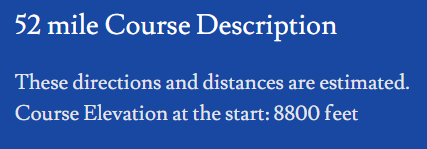The Average Guy Approach to Planning for and Surviving an Ultramarathon
What comes after Training?
Kirk Haines
wyhaines@gmail.com
What Is an Ultramarathon?
A marathon is 42km -- 26.2 miles
What Is an Ultramarathon?
An Ultramarathon is anything longer than a marathon.
What Is an Ultramarathon?
Common Distances
50k
50m
100k
100m
What Is an Ultramarathon?
Most typically ran on trails or dirt roads, and not on paved surfaces.
A Plan Is The Key
Race Planning Checklist
1. Know the Course
Race Planning Checklist
1. Know the Course
2. Plan Your Gear
Race Planning Checklist
1. Know the Course
2. Plan Your Gear
3. Nutrition
Race Planning Checklist
1. Know the Course
2. Plan Your Gear
3. Nutrition
4. Drop Bags
Race Planning Checklist
1. Know the Course
2. Plan Your Gear
3. Nutrition
4. Drop Bags
5. Before and After Race Plans
Race Planning Checklist
1. Know the Course
2. Plan Your Gear
3. Nutrition
4. Drop Bags
5. Before and After Race Plans
6. Crew/Support Instructions
Race Planning Checklist
1. Know the Course


Race Planning Checklist
2. Plan Your Gear
Shoes
- One pair for the whole race, or more?
- Tread?
- Wet?
- Dry?
- Rocky?
- Groomed?
Race Planning Checklist
2. Plan Your Gear
Shoes
Important rule:
Don't wear something you haven't already tried during training!
Race Planning Checklist
2. Plan Your Gear
Trekking Poles
- You expend more energy using them
- They are helpful uphill, and on terrain with poor footing.
- They are helpful if you become injured.
- They are extra weight if they are uneeded.
Race Planning Checklist
2. Plan Your Gear
Belt or Vest for Your Supplies?
- Belt style or vest style?
- Belts are lighter.
- Vests can carry more.
- Distance and conditions influence this
- Marathon or less? Consider a belt.
- Expecting adverse weather conditions, a difficult course, or few aid stations? Consider a vest.
Race Planning Checklist
2. Plan Your Gear
Lighting
- Usually only for > 50M courses
- Waist light? Head light? Handheld?
- Spare batteries?
- Emergency spare light?
- 3AM during a 100 mile run is not the time to have lighting issues
Race Planning Checklist
2. Plan Your Gear
Clothes
- Plan for the expected weather
- Prepare for the unexpected
- Jacket?
- Gloves?
- Spare socks?
- Spare clothes?
- Hat?
- Gaiters?
Race Planning Checklist
3. Nutrition
Fluids
- How hot will it be?
- How far apart are the aid stations?
- Water is heavy; don't carry too much.
Race Planning Checklist
3. Nutrition
Food
- Will the aid stations have things that you are used to?
- Don't eat anything that you haven't tried before.
- How far apart are the aid stations?
- Food is heavy; don't carry too much.
- Calories can be important; a 200 lb. Kirk will burn 7000 - 8000 calories in 50 miles!
Race Planning Checklist
4. Drop Bags
A drop bag is a bag (or bucket; some races allow 5 gallon buckets) of clothes, food, gear, or anything one might think that they need.
Race Planning Checklist
4. Drop Bags
-
A 50k usually allows one bag.
- A 50M usually allows 2 bags.
- A 100M will usually allow 3 or 4 bags.
Expecting water crossings? Pack extra socks (and maybe shoes). Inclement weather? Spare clothes. Favorite foods or a tasty reward for making it that far. Extra batteries for lights. Sunscreen. Bug spray. Blister kits. Etc...
Race Planning Checklist
5. Before/After Race Plans
How are you getting there?
Driving?
Flying and renting a car?
When will you arrive for race packet pickup?
This almost always happens the day before race start.
Race Planning Checklist
5. Before/After Race Plans
Where are you spending the night?
Hotel?
Camping?
Races mornings often mean waking by 2:00 am to 4:00 am to start the day.
Race Planning Checklist
5. Before/After Race Plans
Where are you going after the race?
Camping again? Hotel?
Your body will be hurting. Factor this in.
Race Planning Checklist
5. Before/After Race Plans
What are you driving?
How far?
Your legs will hurt. Everything will hurt. Your legs will just hurt more. Until you've done it
once (or twice), don't underestimate it!
X
Race Planning Checklist
6. Crew/Pacers
Pacers are people who run with you for a portion of the race.
- Usually only for races longer than 50M.
- You may have more than one.
- They may trade off at aid stations.
- They may not carry you, or your gear.
Race Planning Checklist
6. Crew/Pacers
Crew is everyone who is there to help you.
- You don't need pacers or crew, but having them helps.
- Crew needs to know where the aid stations are, and how to get to them.
- They feed you, change your water, change your socks, give you a hug, or give you a push to get you running again. Whatever YOU need.
Running Your Race
Have a Plan
Don't start fast!
Running Your Race
Have a Plan
Be positive!
Running Your Race
Have a Plan
It is a series of small runs, starting at one aid station and ending at the next.
Running Your Race
Have a Plan
One foot in front of the other. Repeat.
Running Your Race
Have a Plan
Use the aid stations.
If you have crew, use them.
Be patient.
Running Your Race
Have a Plan
Walk if you need to.
One step at a time, forward.
Running Your Race
Have a Plan
Drink when thirsty.
Don't forget to eat.
Running Your Race
Have a Plan
One foot in front of the next.